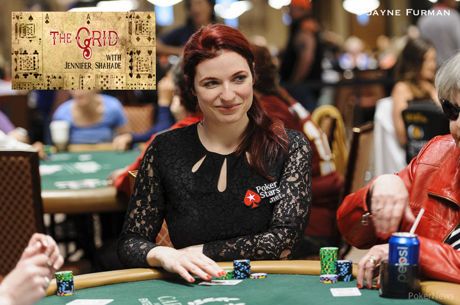Poker Millionaire Reveals His Strategy on Monotone Flops

Most poker players misplay monotone flops (a flop with three cards of the same suit).
This is likely because they are under-researched. When poker players study, they generally start with the most common flop types (as they should).
The mistake players make is treating monotone flops just like the "normal" flop types they're more familiar with.
The best poker players know that monotone flops are quite different from "normal" flops. They're a bit weird, and the strategy you should use needs to account for that.
You're about to learn a better approach for monotone flops, and a lot of the advice in this article will help you improve on other board types as well.
So, let's dive in!
This article is based on Alex "Kanu7" Millar's first video for Upswing Poker.
Alex is one of poker's biggest-ever cash game winners, and he's joined the Upswing team to create content that will help you elevate your cash game skills. He's also been working on an advanced cash game course, which will be released in January 2020.
How Things Change on Monotone Flops
Alex starts the video by comparing the average bet frequency and sizing for all flops versus monotone flops (calculated using a private solver). This table sums up the comparison:

As you can see, the bet frequency has lowered from 62% to 51% and the bet sizes skew smaller. To quote Alex:
"So, for some reason we've decided that we are going to put a lot less money in on monotone flops, when we're c-betting, than on other flops. Not only are we c-betting less often, but we're also c-betting smaller sizes on average."
"And [the reason for this] is not immediately intuitive. Both players have got some flushes [in their range]. Both players have got a bunch of flush draws [in their range]. If you're just thinking about how the equities of each range match up against each other, you might think there's not a huge amount of difference between a monotone flop and a non-monotone flop."
"Yet we're really reluctant to put in as much money as we normally are. Let's have a think about why that is."
Before getting into Alex's specific advice for c-betting on monotone flops, it's important to understand bet sizing fundamentals.
Bet Sizing Fundamentals
When your range has far more very strong hands than your opponent's range, you're generally going to want to bet big with those strong hands (and the appropriate number of bluffs for balance). On the other hand...
When your range contains far fewer very strong hands than your opponent's range, you're generally going to be limited to betting small.
There are other factors to consider, of course, but the rules of thumb above are a great starting point.
Let's take a look at a couple example flops featuring one of the best cash game players of all time, OtB_RedBaron.
3-handed $200/$400 on PokerStars. Effective stacks of $42,919.
OtB_RedBaron raises to $870 on the button. Alex folds. Phil Ivey calls from the big blind.
Flop ($1,940) A♣K♦9♣
Ivey checks. OtB_RedBaron bets $2,651. Ivey folds.
Why do you think OtB_RedBaron chose to bet so big (1.4 times the pot) on this flop? Consider your answer before reading on.
Okay, ready?
OtB_RedBaron has a huge advantage when it comes to very strong hands on this flop.
As the preflop raiser, he can have AA, KK, 99, AK, and AQ. As the preflop caller, Phil Ivey can have none of those hands because he would have 3-bet before the flop if he did.
By using a big size, OtB_RedBaron puts Ivey in a very difficult spot. Ivey simply doesn't have enough strong hands to counteract it. He can't check-raise because he doesn't have those very strong hands, and he's also going to have to worry about facing big bets on future streets.
The next example:
4-handed $200/$400 on PokerStars. Effective stacks of $125,542.
OtB_RedBaron raises to $1,010 on the button. TrueTeller folds. Alex calls from the big blind.
Flop ($2,220) 5♠4♠2♥
Alex checks. OtB_RedBaron bets $686. Alex folds.
Contrary to the last hand, OtB_RedBaron chose to use a small bet size (30% of the pot). Why do you think he chose this small size?
Answer time!
Alex has an advantage when it comes to very strong hands on the flop.
As the preflop caller in the big blind, Alex has 63s, A3s, A3o, 54s, 54o, 52s, and all of the sets in his range. As the preflop raiser, OtB_RedBaron can have some of those hands (the sets, A3s, 54s, and maybe 63s), but he is unlikely to have raised preflop with A3o, 54o, and 52s.
Because of his disadvantage at the top of the ranges, OtB_RedBaron doesn't really have the option to bet big. Most of the hands he will want to value bet (overpairs and flopped pairs) are weaker on this flop and he won't want to get loads of money in the pot with them.
Bet Sizing on Monotone Flops
How do the two examples above relate to monotone flops? Here's what Alex had to say:
"If we think about a monotone flop, it is [much more like] the second example. It's not exactly like the second example — things are a little bit different...
...but what's going to be very clear is both players have a bunch of flushes. So, at the top of the ranges, it is going to be relatively equal...
After that, we've got the sets and two pairs. Any advantage we have in the [number of] sets and two pairs is just going to be a little further down in our ranges.
So we're not going to be able to bet the really big sizes that we see in other situations, like that A-K-9. That's why monotone flops end up with a smaller bet size than other flops."
For example:
3-handed $100/$200 on PokerStars. Effective stacks of $18,073.
OtB_RedBaron raises to $435. forhayley folds. Alex calls in the big blind.
Flop ($970) Q♥10♥2♥
Alex checks. OtB_RedBaron bets $299. Alex folds.
As you can see, OtB_RedBaron used a 31% pot-sized bet on this monotone flop. That's the same size he used in the second example flop (5♠4♠2♥).
Takeaways
Alex concluded the video by going over the main takeaways:
- Big advantage at the top of the ranges → Bet bigger size.
- Most of our hands that want to bet are weaker → Bet smaller size.
- No big advantage at the top of the ranges → Not using big sizes.
- On monotone flops, your default strategy should be to c-bet around half the time for a 25-33% pot sizing.
If you want to hear each of these takeaways explained in greater detail, watch at least the last 2.5 minutes of Alex's video.
Ready for more? Watch part 2 of Alex’s series on monotone flops. And keep an eye out for his new cash game course, which is coming to upswingpoker.com in January 2020.
Versus OtB_RedBaron's c-bet on that Q♥10♥2♥ flop, what hands would you check-raise in Alex's spot? Drop your answer in the comments below!
Sponsor-generated content by Upswing Poker












